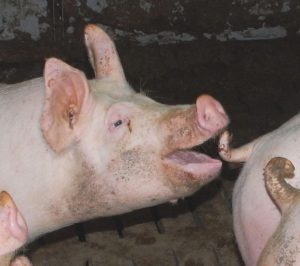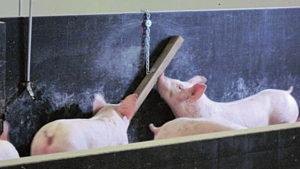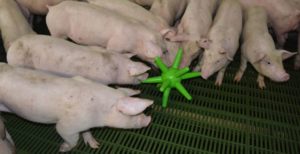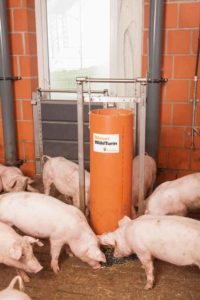Different scenarios and designs have been tested in order to better understand pigs’ perception and behaviour. This process informed the design of DIY objects which are collected in the ‘Pig Toy Construction Manual’.
WHY
Pigs which find themselves in a natural environment use most of their time to dig for food or explore territory. In modern farming environments they are not able to follow their nature and become bored, the surpression of it poses serious risks to the animals’ health.
Tail and ear biting, aggressive behaviour or apathy are common results of bored pigs in a factory farming environment.

If stress becomes standart, the animals’ immune system responds and becomes weaker. Bored pigs eventually become sicker more often than happy pigs.
The World Organisation for Animal Health states that animal diseases account for losses of at least twenty percent in animal husbandry around the world. That equals an amount of 60 million tonnes of meat per year.
There is evidence that providing toys and proper enrichment to pigs from birth increases their intelligence, which in turn makes it easier for them to overcome fear and adapt to change. They are capable to handle stress better if they had learned to deal with change in the past.
The biggest issue with most available toys on the market is that pigs are generally interested in everything which is newly introduced into their environment, but if it does not provide adequate enrichment qualities that go beyond the factor of being new, they loose interest in the objects quickly after.
SELFMADE TOYS
Many farmers seem to provide their animals self made solutions that are common in that context, like a rope, a ball, or a chain which had not been produced for the purpose of hog entertainment. These improvised make-do solutions are easy to implement and cheap, but mostly not efficient in entertaining pigs for a longer period.

COMMERCIAL TOYS
A small market for pig toys established itself since the introduction of the European Directive on pig enrichment material. The producers promise that their toys entertain the pigs and reduce suffering, aggression and biting.

Some of these gadgets have similiarities to dog toys, others aren’t easily recognizable as toys at all.
Their shapes and the materials they consist of make them recognizable as industrial products, yet most of them are comparable to the self made solutions of the farmers in terms of entertainment qualities.
The farmers who have been part of this project all shared a critical point of view about the efficiency as well as the cost benefit balance of most commercial toys.
PIG TOYS BASED ON RESEARCH
Besides those cheaply produced mass products, other research-based toys have been developed.
One of them has been engineered over 8 years by a team of researchers at the faculty of organic agriculture (University of Kassel in Germany) ‘Wühlkegel’ or ‘Rooting Cone’.

Dr. Uwe Richter, involved in the development process stated that “even after several months, they still play with it – they even lie around it or sleep with their heads pointing toward it. We did not expect it was so good.”
The combination of satisfying the pigs’ urge to root in combination with the balls’ shape and the yellow colour make the Wühlkegel more attractive to the pigs than other commercially available toys, according to its inventors.

Another solution is the so called ‘foraging tower’. It consists of a large tube which can be filled with straw and other organic matter. A small gap under the tube releases enough straw to provide the animals with rooting material, yet not enough to block the holes in slattered floor tiles of conventional farms.
The developers underline the efficiency of the tower, observing a reduction of tail biting as well as weight gain on the pigs.
This device costs more than 200€.
For more information, images or videos send a message – hi[at]manuel.plus
